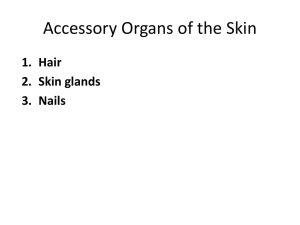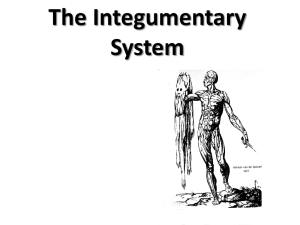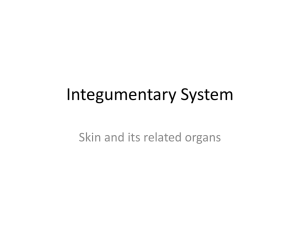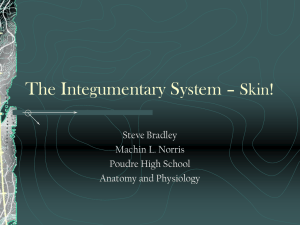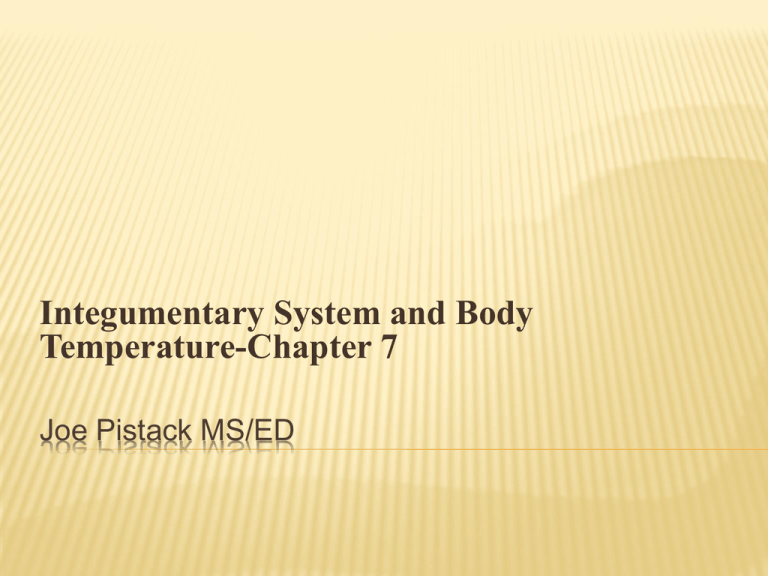
Integumentary System and Body
Temperature-Chapter 7
Joe Pistack MS/ED
INTEGUMENTARY SYSTEM
Integumentary system includes:
The skin
Accessory structures:- sweat glands
-oil glands
- hair
- nails
FUNCTIONS OF SKIN
The skin performs the following functions:
Keeps
harmful substances out of the body and helps
retain water and electrolytes.
Protects
the internal structures and organs from
injuries due to blows, cuts, harsh chemicals, sunlight
burns, and pathogenic microorganisms.
Performs
an excretory function. Secretes water and
small amounts of urea.
FUNCTIONS OF THE SKIN
Acts as a gland by synthesizing vitamin D. Vitamin
D is necessary for absorption of calcium from the
digestive tract.
Performs a sensory role by housing the sensory
receptors for touch, pressure, pain, and temperature.
Plays an important role in the regulation of body
temperature.
STRUCTURE OF THE SKIN
Skin:
Considered an organ
Also called integument or cutaneous membrane
Skin has 2 layers:
Epidermis-outer layer
Dermis-inner layer
Dermatology-the study of skin and skin disorders.
LAYERS OF SKIN
Epidermis-thin outer layer of skin.
Composed of stratified squamous epithelium.
Has no blood supply of it’s own, avascular.
Oxygen and nutrients diffuse into the epidermis
from blood supply from the dermis.
LAYERS OF SKIN
The epidermis can be divided into 5 layers the two of
interest here are the deeper stratum germinativum
and the more superficial stratum corneum
1.Stratum germinativum-lies on top of the dermis.
-has access to a rich supply of blood.
-cells of this layer constantly divide, push old cells
to the surface.
LAYERS OF SKIN
Changes take place as cells move away from surface:
1. cells begin to die
2. keratinization takes place
Keratinization-process whereby tough protein
called keratin is deposited within the cell, keratin
hardens and flattens the cells as they move toward
surface. This makes the skin water-resistant.
LAYERS OF THE SKIN
Stratum Corneum:
Surface
layer of the epidermis.
Composed of about 30 layers of dead cells.
Dead cells are continuously sloughed off.
Sloughed cells are called dander, dandruff when
clumped by oil on the skull.
LEVELS OF SKIN
Insensible perspiration-500ml/day of perspiration
that is lost through the skin.
Sensible perspiration-due to activity of the sweat
glands.
If the epidermis is damaged, the rate of insensible
perspiration increases. E.g. burns
LEVELS OF SKIN
Dermis:
Located
under the epidermis.
Largest portion of the skin
Composed of dense, fibrous, connective tissue.
Contains collagen and elastin fibers that make the skin
strong and stretchable. E.g. Pregnancy
LAYERS OF SKIN
Subcutaneous layer or hypodermis:
Not
considered part of the skin,
Lies under the skin.
Composed primarily of loose connective and adipose
tissue.
LAYERS OF SKIN
Subcutaneous tissue performs two main roles:
1. Helps to insulate the body from extreme
temperature changes in the external environment.
2. Anchors the skin to the underlying structures.
Several areas of the body have no subcutaneous layer and
are anchored directly to bone
Drugs are administered (SubQ) because hypodermis has a
rich supply of blood vessels.
LAYERS OF SKIN
SQ INJECTIONS
22 to20 ga. 5/8 to 3/4 long
SKIN COLOR
Skin color is determined by:
Genetic factors
Physiological factors
Disease
Melanocytes-skin cells within the epidermal layer.
Melanin-darkening pigment, stains the surrounding
cells causing them to darken.
SKIN COLOR
The more melanin, the darker the skin.
Amount of melanin secreted determines the skin
color.
Exposure to ultraviolet sunlight increases the
secretion of melanin=suntan.
MALFUNCTIONING MELANOCYTE
Conditions involving malfunctioning melanocyte:
Albinism:
- melanocytes fail to secrete melanin.
- skin, hair, and iris (colored part of eye) are white.
Vitiligo:
-loss of pigment in certain areas of skin.
-creates patches of white skin.
Freckles and Moles:
-Areas in the skin where melanin is concentrated
Malignant melanoma
-A mole that has changed in character and has become cancerous
SKIN CONDITIONS
Carotene-yellowish pigment to skin.
Cyanosis-blue look to skin, result of poorly
oxygenated blood.
Blushing-dilation of the blood vessels.
Pallor-constriction of blood vessels, decrease in
oxygenated blood.
ACCESSORY STRUCTURES
Accessory structures include:
- hair
- nails
- glands
Hairless body parts: palms of hands, soles of feet,
lips, nipples, and parts of the external
reproductive organs.
PARTS OF HAIR
Chief parts:
Shaft-part above the surface of the skin.
Root-part that extends from the dermis to the
surface.
Hair follicle-formed by downward extension of
epithelial cells.
FUNCTIONS OF HAIR
Functions:
Eyelashes and eyebrows-protect the eyes from
dust and perspiration.
Nasal hairs trap dust and prevent it from entering
the lungs.
Hair of the scalp keeps us warm.
FUNCTION OF HAIR
Hair growth-influenced by sex hormones.
Puberty-growth of hair in axillary and pubic areas
in male and females.
Hirsutism-excessive hair growth in females,
caused by too much testosterone.
HAIR FOLLICLE
Epidermal cells –receive blood supply from the
dermal blood vessels.
Keratinization of cells- cells die as they move
away from their source of nourishment.
Hair that we brush, blow dry, and curl is dead.
HAIR COLOR
Hair color:
Genetically controlled by the amount of melanin.
Abundance of melanin-dark hair.
Less melanin-blond hair.
Absence of melanin-white hair.
SHAPE OF HAIR
Shape of the hair shaft:
Determines the appearance of hair.
Round shaft produces straight hair.
Oval shaft produces wavy hair.
Flat hair shafts produce curly and kinky hair.
HAIR FOLLICLE
HAIR FOLLICLE
Arrector Pili muscle- attached to the hair follicle.
Bundle of smooth muscle fibers, when these
muscles contract, hair stands on end.
Contract when cold or frightened.
Also called goose bumps.
HAIR STANDING ON END
ALOPECIA
Alopecia-loss of hair.
Male-pattern baldness
most common type.
Characterized by a gradual loss of hair.
Drug toxicity
second most common type.
Eg. Chemo, radiation.
HAIR LOSS FROM RADIATION
NAILS
Nails:
Thin plates of stratified squamous epithelial cells.
Contain a hard form of keratin.
Found on the distal end of the fingers and toes.
Protect structures from injury.
NAIL STRUCTURE
Structure:
Free
edge
Nail body (finger nail)
Nail root
NAIL STRUCTURE
Nail growth-determined by half-moon shaped lunula
located at the base of the nail.
As nail grows, it slides over the nailbed.
Underlying dermal layer contains blood vessels
which give pink color to nail.
Cuticle-fold of stratum corneum-grows onto
proximal portion of the nail body.
NAIL STRUCTURE
NAILS
NAILS
ASSESSMENT
Assessment of the nails should include:
-shape
-dorsal curvature
-adhesion to the nail bed
-color
-thickness
NAIL CONDITIONS
clubbing-condition that indicates fingertips have
received an insufficient supply of oxygenated
blood over a period of time.
Fingertips become large, nails become think,
hard, shiny and curved at the free end.
Causes-chronic heart and lung disease.
CLUBBING OF FINGERS
CYANOSIS
Cyanosis-poor oxygenation makes the blood
appear bluish, this in turn makes the nails appear
bluish.
Nail abuse-trauma to the nail that causes the nail
to thicken and hypertrophy.
Brittle- generally due to poor oxygenation or poor
nutrition, or anemias.
CYANOSIS
GLANDS
Two major glands:
Sebaceous glands
Sweat glands
Sebaceous glands or oil glands-associated with the
hair follicles, found in all body areas that have hair.
Sebum-oily substance that flows into hair follicle or
onto surface of skin.
GLANDS
Function:
Sebum lubricates and helps waterproof skin and
hair.
Inhibits bacteria on the surface of the skin.
Production decreases with aging, results in dry
skin and brittle hair.
Vernix caseosa-cream cheese covering that babies
are born with, secreted by sebaceous glands.
GLANDS
Glands can become blocked by accumulating
sebum and debris.
A blackhead
forms when sebum is exposed to air and
dries out
A pimple
forms when the blocked sebum becomes
infected with staphylococci-it becomes a pustule
SEBACEOUS GLANDS
SWEAT GLANDS
Sweat glands or sudoriferous glands:
Located
in the dermis.
Secrete sweat.
Sweat is secreted into a duct that opens onto the
skin as a pore.
We have approximately three million sweat
glands.
SWEAT GLANDS
Two types of sweat glands:
1) Apocrine glands-usually associated with
the hair follicles, found in the axillary and genital
areas.
Respond to emotional stress and become activated
when a person is frightened, upset, in pain or sexually
excited.
Become activated during puberty.
SWEAT GLANDS
Body odor- occurs when the substances in sweat
are degraded by bacteria into chemicals with a
strong unpleasant odor.
2) Eccrine glands-more numerous and widely
distirubuted throughout the body. Especially
numerous on the forehead, neck, back, upper lip,
palms, and soles.
GLANDS
Eccrine
Not
glands:
associated with hair follicles.
Sweat that is secreted plays an important role
in temperature regulation.
As sweat evaporates on the skin, heat is lost.
Sensible perspiration-secreted by the eccrine
glands, can secrete a gallon of sweat per hour.
GLANDS
Modified sweat glands:
Ceruminous –found in the external auditory
canal, secrete cerumen.
Cerumen-
yellow, sticky, wax-like secretion that
repels insects and traps foreign materials.
Mammary glands-located in the breasts, secrete
milk.
BODY TEMPERATURE
Normal body temperature is 98.6 degrees F .
Body temp. differs from one part of the body to
another.
Core temperature-reflects the temperature of the
inner parts of the body, (cranial, thoracic, and
abdominal cavities).
Shell temperature-reflects the temperature of the
skin and mouth.
BODY TEMPERATURE
Thermoregulation-the mechanism whereby the body
balances heat production and heat loss.
Failure to regulate body temperature causes the body
temperature to fluctuate.
Hypothermia-excessive decrease in body temperature.
Hyperthermia-excessive increase in body temperature.
Extreme changes in body temperature may be fatal.
HEAT LOSS
80% of heat loss occurs through the skin.
20% is lost through the respiratory system and
excretory products.
Heat loss occurs by four means:
Radiation
Conduction
Convection
Evaporation
HEAT LOSS
Radiation-heat is lost from a warm object (the body) to the
cooler air surrounding the warm object. Eg. Person loosing
heat in a cold room.
Conduction-loss of heat from a warm body to a cooler
object in contact with the warm body.
Eg. Warm person becomes cold when sitting on a block of
ice.
Eg. Cooling blanket for hyperthermia-warm object
(feverish patient) looses heat to the cooler object, the
cooling blanket.
HEAT LOSS
Convection-loss of heat by air currents moving
over the surface of the skin. E.g. Fan moving
across the surface of the skin.
Evaporation-heat may be lost through changing a
liquid (sweat) to a gas.
E.g. during strenuous exercise, sweat on the
surface of the skin evaporates and cools the body.
BODY TEMPERATURE
Normal body temperature is regulated by several
mechanisms:
- Hypothalamus-thermostat of the body, located in
the brain.
-senses changes in body temperature and sends
information to the skin. (blood vessels, sweat
glands and skeletal muscle).
BODY TEMPERATURE
Exercise
Temperature elevates
Blood vessels dilate
Increased blood flow to the skin
BODY TEMPERATURE
Heat is transferred to deeper tissue surfaces
Sweat glands activate
Heat is lost as sweat evaporates
Body temperature lowers
BODY TEMPERATURE REGULATION
RESPONSE TO DECREASING TEMP.
Decreased temperature:
Blood vessels constrict.
Traps blood and heat in the deeper tissues
(prevents heat loss)
Sweat glands become less active, preventing heat
loss.
RESPONSE TO DECREASING TEMP.
Skeletal muscles contract vigorously and
involuntarily causing shivering and an increase
in the production of heat.
Contraction of the arrector pili muscles causes
goose bumps indicating a decline in body temp.
TEMPERATURE REGULATION
BURNS
Classified according to depth.
Classified as either partial-thickness burns or fullthickness burns.
Partial thickness are divided into first-degree and
second-degree burns.
FIRST DEGREE BURNS
First degree burns:
Red
Painful
Slightly edematous (swollen)
Only epidermis involved
E.g. sunburn
SECOND DEGREE BURN
Second degree burns:
Redness
Pain
Edema
Blister formation
May appear red tan or
white
THIRD DEGREE BURNS
Third degree burns:
(full thickness burns)
Both epidermis and
dermis are destroyed
Painless-sensory
receptors destroyed
May appear white, tan,
brown, black or cherry
red
BURNS
Rule of nines:
System used to measure the extent of burns.
Total body surface is divided into regions.
The assigned percentages are related to the
number 9.
BURNS
BURNS
Severe burns are associated with eschar
formation.
Eschar is dead, burned tissue that forms a thick,
inflexible scab-like layer over the surface.
Can
act as a tourniquet and cut off blood supply to
extremity, or if the burn is in the trunk area it cal limit
the ability to breath.
Though initially sterile it can become a breeding
ground for bacteria, and their toxic secretions can
easily enter the blood.
AGING SKIN
As we age:
Epidermis becomes thinner.
Skin is more translucent.
Melanocyte decreases.
Dermis becomes thinner,
Decreased amount of collagen and elastin fibers.
Increased wrinkles.
Skin heals slower.
AGING SKIN
AS WE AGE!

